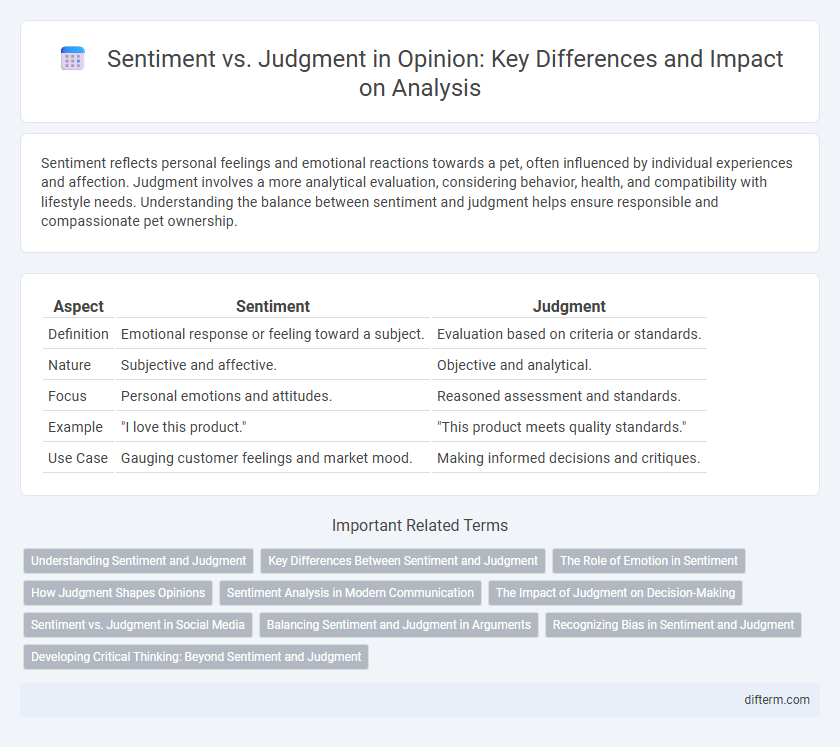Sentiment reflects personal feelings and emotional reactions towards a pet, often influenced by individual experiences and affection. Judgment involves a more analytical evaluation, considering behavior, health, and compatibility with lifestyle needs. Understanding the balance between sentiment and judgment helps ensure responsible and compassionate pet ownership.
Table of Comparison
| Aspect | Sentiment | Judgment |
|---|---|---|
| Definition | Emotional response or feeling toward a subject. | Evaluation based on criteria or standards. |
| Nature | Subjective and affective. | Objective and analytical. |
| Focus | Personal emotions and attitudes. | Reasoned assessment and standards. |
| Example | "I love this product." | "This product meets quality standards." |
| Use Case | Gauging customer feelings and market mood. | Making informed decisions and critiques. |
Understanding Sentiment and Judgment
Sentiment reflects emotional responses and personal feelings, often influencing opinions subconsciously, while judgment involves critical evaluation based on evidence and reasoning. Understanding the distinction between sentiment and judgment enhances decision-making by balancing emotional intuition with rational analysis. Accurate interpretation of sentiment can reveal underlying attitudes, whereas sound judgment ensures objective conclusions.
Key Differences Between Sentiment and Judgment
Sentiment refers to the emotional response or feeling toward an object, event, or idea, often subjective and driven by personal biases or experiences. Judgment involves a reasoned evaluation or conclusion based on evidence, logic, and principles, emphasizing objectivity and critical thinking. Key differences include sentiment's emotional basis versus judgment's analytical foundation, and sentiment's focus on feelings compared to judgment's focus on assessments or decisions.
The Role of Emotion in Sentiment
Emotion serves as the primary catalyst in sentiment formation, directly influencing how individuals perceive and respond to stimuli. Unlike judgment, which relies on rational analysis and objective criteria, sentiment is inherently subjective and shaped by personal feelings and affective experiences. The intensity and nature of emotions determine the positivity or negativity of sentiment, highlighting the critical role of emotional processes in shaping human attitudes.
How Judgment Shapes Opinions
Judgment plays a critical role in shaping opinions by filtering emotional responses through reasoning and evaluation, leading to more structured and informed viewpoints. While sentiment captures immediate feelings, judgment assesses evidence and context, creating opinions that reflect deeper understanding and critical analysis. This cognitive process strengthens the reliability and coherence of opinions, making them less prone to impulsive shifts based on fleeting emotions.
Sentiment Analysis in Modern Communication
Sentiment analysis plays a crucial role in modern communication by accurately identifying emotions expressed in texts across social media, customer reviews, and online forums. This technology enables businesses and organizations to gauge public opinion, improve user experience, and tailor marketing strategies effectively. By distinguishing sentiments from subjective judgments, sentiment analysis enhances automated decision-making and fosters more nuanced understanding of human expression.
The Impact of Judgment on Decision-Making
Judgment significantly shapes decision-making by influencing how information is evaluated and prioritized, often leading to faster yet sometimes biased outcomes. Unlike sentiment, which reflects emotional responses, judgment involves critical analysis and reasoning, directly affecting choices in complex scenarios. Understanding the weight of judgment processes enhances the accuracy and effectiveness of decisions across personal and professional contexts.
Sentiment vs. Judgment in Social Media
Sentiment in social media reflects users' emotional reactions expressed through likes, comments, and shares, often driven by personal feelings rather than objective evaluation. Judgment involves critical assessment and reasoned opinions, enabling more nuanced discussions and informed decision-making. Understanding the distinction between sentiment and judgment helps brands and analysts accurately interpret online feedback and tailor engagement strategies.
Balancing Sentiment and Judgment in Arguments
Balancing sentiment and judgment in arguments enhances persuasive communication by integrating emotional appeal with logical reasoning. Expressions grounded in sentiment evoke empathy and connect with audiences on a personal level, while judgments provide critical analysis and objective evaluation to validate claims. Effective arguments harmonize these elements, ensuring emotional resonance does not overshadow rational credibility.
Recognizing Bias in Sentiment and Judgment
Recognizing bias in sentiment and judgment involves understanding how personal emotions can cloud objective evaluation, leading to skewed perspectives. Sentiment often reflects subjective feelings, whereas judgment demands critical analysis based on evidence and fairness. Developing awareness of one's cognitive biases enhances the ability to differentiate between emotional reactions and reasoned conclusions.
Developing Critical Thinking: Beyond Sentiment and Judgment
Developing critical thinking requires moving beyond simple sentiment and judgment to analyze evidence and reason objectively. Emphasizing cognitive skills such as evaluation, inference, and synthesis fosters deeper understanding and more nuanced perspectives. This approach enhances decision-making and promotes intellectual maturity by grounding opinions in logic rather than emotion.
sentiment vs judgment Infographic

 difterm.com
difterm.com